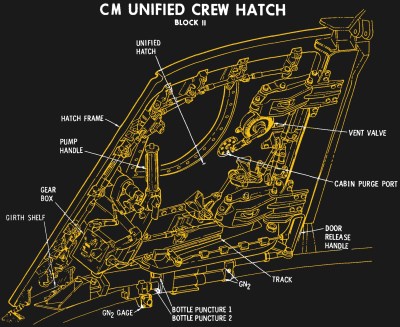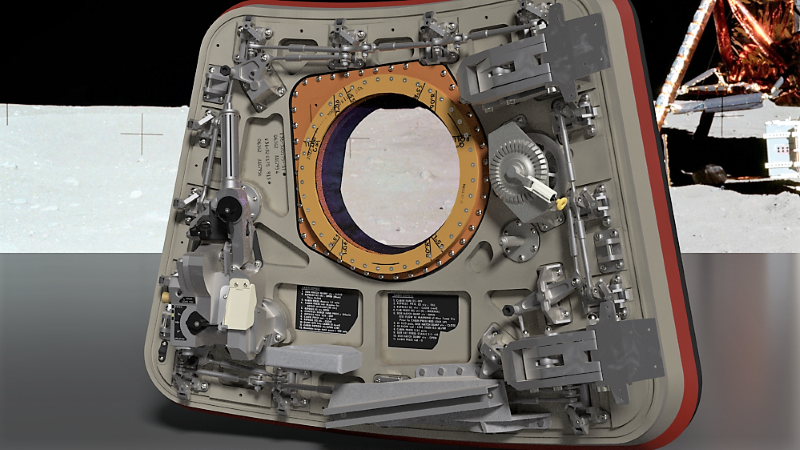The 50th anniversary of the first Moon landing is rapidly approaching, and uber space-nerd Adam Savage is in the thick of the celebration of all the amazing feats of engineering that made humanity’s first steps out of the cradle possible. And in a grand and very hacker-friendly style, we might add, as his Project Egress aims to build a full-scale replica of the Apollo 11 Command Module Columbia’s hatch.
A Hatch to be Reckoned With
A hatch might seem like an odd artifact to recreate, but considering its complexity, it’s the perfect target for such an effort. The hatch that Project Egress will be building is from Block II CMs, which was completely redesigned in response to the tragedy of Apollo 1. The fire that killed Guss Grissom, Ed White, and Roger Chaffee inside their Block I capsule was inescapable due to the design of the hatch, a two-piece plug that opened inward and was pushed firmly into its seals by the pressure difference between the capsule interior and atmospheric pressure. The three crew members never had a chance once the fire started, accelerated as it was by the pure oxygen atmosphere of the capsule.

The Block II hatch, dubbed the “Unified Crew Hatch” or UCH, was designed with crew safety in mind. The design requirements stated that the hatch must be able to be opened by the crew within 3 seconds, and allow for complete crew egress in 30 seconds. They also wanted the hatch to open to a wider angle, and for it to be able to prop open for extended extravehicular activity. That last requirement added a lot of complexity, because making sure that the hatch latches securely again for re-entry is critical. Consequently, a backup latching mechanism had to be included in the UCH design.
To satisfy those requirements, the Block II UCH became a 225 pound (102 kg) beast. It had fifteen latches that could be simultaneously retracted with a few strokes of a handle on a hydraulic pump, or by use of the backup system. The UCH also had vents for rapidly equalizing cabin pressure to the ambient pressure, a special mechanism to open the outer boost cover hatch until it was jettisoned along with the escape tower, beefy hinges to keep the hatch propped open securely, and a gas spring counterbalance system to assist opening and keep the hinges from overextending. The Block II UCH was flown on all the manned missions and performed flawlessly.
This Way to the Egress
All this makes the UCH a great artifact to recreate, but it means that Project Egress is far too big a job for one person. To spread the work around and make the build more interesting, Adam has enlisted over 40 well-known makers and hackers and assigned them all a specific part to recreate. The list reads like a who’s who of the maker movement: Jimmy Diresta, This Old Tony, John Saunders at NYC CNC, Fran Blanche from FranLab, and our own Quinn Dunki, also known as BlondiHacks. The list includes DIYers, prop makers, cosplayers, 3D-printing nerds – the entire spectrum of maker genres is represented.
Here’s the really interesting part: each maker will choose the medium for their part. Some will work in metal, some in wood, and there will no doubt be 3D-printed parts too. Pretty much every method and material in the hacker armamentarium will come to bear, and the parts will be a mish-mash of everything that makes what we do every day so powerful and so much fun.
The Reveal
The culmination of Project Egress happens on July 18th when Adam will take the collection of parts to the Smithsonian’s National Air and Space Museum and assemble them in front of a live audience. It’s not clear if there will be a live stream of the event, but it would be a crying shame if there isn’t. If you’re in the DC area, it’d certainly be worth dropping by.
We really like the sound of this event, and we can’t wait to see the builds that come out of it. Both Fran Blanche and Quinn Dunki have already posted their builds; Fran did videos on the design and build of one of the latch assemblies, rendered in wood, while Quinn machined a latch tie rod from aluminum.
Project Egress looks like it’s going to be a lot of fun, and hats off to Adam for coordinating it – and for giving up his annual trip to San Diego Comic Con in favor of the live build – and to all the hackers he has roped into the project. We’ll keep track of progress along the way, and hopefully be able to report on the big reveal at the end.
[Featured images: National Air and Space Museum]
















What with the DSKY being ready, the computer coming along nicely and now with the hatch being worked on, the Makers will be bouncing around on the Moon before NASA can even get back to LEO.
Isn’t that essentially what is happening already? NASA already getting jerked around again by the admin just two weeks after seemingly being sent off on a mission to the Moon, SLS is still a congressional social service program for gulf states and poor old Boeing, and the likes of SpaceX and SpaceIL are looking to play around on the Moon and Mars. That sounds like the makers are out to play while NASA is stuck at home doing busywork chores.
While I love the snark, the other thing that NASA is doing that none of the others are: science.
I’m sorry I must have miss read. SpaceX doesn’t do science?
They do Money and Engineering.
I wish them luck!
(In that it all comes together without needing extra drilling/grinding)
” It’s not clear if there will be a live stream of the event,”
Sounds like a job for CSPAN2!
Great writeup, Dan! This was an amazing project to be a part of. I’m particularly glad that Fran was included, because I can’t think of a better person to be involved in an Apollo project! By the way, if you can get to the DC area on the day, you can watch Adam put together the project live, and the video will also be on the Tested channel on YouTube.
Also a shout out to Jen Schachter, the project manager, and Andrew Barth who modeled all the parts in Fusion 360 (and gave us all lovely mechanical drawings). They are the unsung heroes of this project.
Thanks Quinn, and good to hear a little of the backstory. I figured there were a lot of people working in the trenches. I’d love to hear more about how they modeled everything. Did they work from original drawings or did they have access to a UCH for 3D-scans or manual measurements?
My son, Andrew, who modeled all the pieces just about every waking moment in between 3rd year engineering classes and orchestra practice and concerts (as first chair French Horn player) at Bradley U and some sleep using paper copies of original blueprints provided by Smithsonian, files of 3D scan files of the hatch Air & Space did a few years back, and from paper prints from microfilm archives in Washington DC, photos and internet searches, historical articles and anything that would help him understand how it was built and operated.
Hey Dan, I’m the CAD modeler for this project! The Smithsonian Digitization Program Office scanned the hatch at the same time as the command module, and I received that scan data. From there, I measured features in Fusion and produced the model piece-by-piece. I used reference photos to try to gain an understanding of the function of each of the pieces and went from there. I did have some technical drawings for the manual drive gearbox, and am releasing an update for the files that includes a functional version of the gearbox, so anyone who wants to make it all can have a nearly fully-operational hatch. Let me know if you have any questions!
I saw the original hatch in question as well as the Columbia module itself back in Feburary in Pittsburgh, where I had the honor of having a lunar lander module mockup I helped make on display in the same exhibition as the original stuff.
That hatch is insanely mechanically complex. I took a lot of pictures of it, tring to figure out how the hell an engineer came up with all the strange angled linkages to make the thing work.
That’s a hell of an object to try to recreate. Manual machinists on that have their work cut out for them, some very creative setups will be needed to mill some of those brackets
I believe Columbia is on display at the Seattle Museum of Flight and Space right now, through September I think. It’s only a five hour drive from me, so I really should go make a day of it. But, Seattle…
Don’t forget the inanimate carbon rod!
https://frinkiac.com/img/S05E15/1252250.jpg
This Old Tony has posted his part(s) video too.